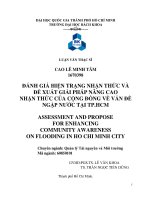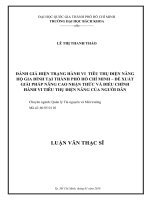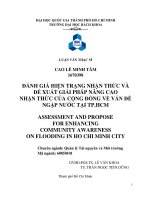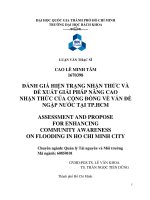Đề Xuất Giải Pháp Nâng Cao Nhận Thức Về Bảo Tồn Đa Dạng Sinh Học Của Người Dân Địa Phương Vùng Đệm Vườn Quốc Gia Cát Tiên - Tỉnh Đồng Nai.pdf
Bạn đang xem bản rút gọn của tài liệu. Xem và tải ngay bản đầy đủ của tài liệu tại đây (1.02 MB, 58 trang )
VIETNAM GENERAL CONFEDERATION OF LABOR
TON DUC THANG UNIVERSITY
FACULTY OF ENVIRONMENT AND LABOR SAFETY
DAO THI HUYEN
PROPOSING SOLUTIONS TO RAISE
AWARENESS ON BIODIVERSITY
CONSERVATION OF LOCAL PEOPLE
IN THE BUFFER ZONE OF CAT TIEN
NATIONAL PARK - DONG NAI
PROVINCE
GENERAL SPECIALIZED MODULE OF
ENVIRONMENTAL SCIENCE
HO CHI MINH CITY, 2022
VIETNAM GENERAL CONFEDERATION OF LABOR
TON DUC THANG UNIVERSITY
FACULTY OF ENVIRONMENT AND LABOR SAFETY
DAO THI HUYEN – 917H0006
PROPOSING SOLUTIONS TO RAISE
AWARENESS ON BIODIVERSITY
CONSERVATION OF LOCAL PEOPLE
IN THE BUFFER ZONE OF CAT TIEN
NATIONAL PARK - DONG NAI
PROVINCE
GENERAL SPECIALIZED MODULE OF
ENVIRONMENTAL SCIENCE
Advised by
PhD. Le Buu Thach
HO CHI MINH CITY, 2022
ACKNOWLEDGMENT
I would like to extend my deepest thanks to:
First, I would like to thank the teachers at the Faculty of Environment and Labor
Protection, Ton Duc Thang University, who have always created favorable conditions
for me and enthusiastically helped me during my study here.
Second, I would like to thank for my Instructor, PhD. Le Buu Thach who directly guided
me throughout the research and completion of this project. He gives me advice and
inspires me a lot. Without his support, I wouldn't know how I would have completed this
study.
Third, I would like to thank the teachers and brothers and sisters at the Southern Institute
of Ecology for giving me the opportunity to learn more knowledge, contribute ideas and
create conditions for me to conduct field surveys in Cat Tien National Park.
Next, I would like to thank the local people in the buffer zone communes of Cat Tien
National Park for their enthusiastic support during the survey so that I could successfully
complete this study.
Finally, I would like to thank my family and friends because without their
encouragement and giving me the best conditions, I would have given up soon.
Once again sincerely thank you.
Ho Chi Minh City, May 1, 2022
Author
Dao Thi Huyen
iv
This thesis was carried out at Ton Duc Thang University
Advisor: PhD. Le Buu Thach
This thesis is defended at the Undergraduate Thesis Examination Committee was hold
at Ton Duc Thang University on
Confirmation of the Chairman of the Undergraduate Thesis Examination Committee
and the Dean of the faculty after receiving the modified thesis (if any).
CHAIRMAN
……………………….
DEAN OF FACULTY
……………………….
v
DECLARATION OF AUTHORSHIP
I hereby declare that this thesis was carried out by myself under the guidance and
supervision of PhD. Le Buu Thach and that the work and the results contained in it are
original and have not been submitted anywhere for any previous purposes. The data and
figures presented in this thesis are for analysis, comments, and evaluations from various
resources by my own work and have been duly acknowledged in the reference part.
In addition, other comments, reviews and data used by other authors, and
organizations have been acknowledged, and explicitly cited.
I will take full responsibility for any fraud detected in my thesis. Ton Duc
Thang University is unrelated to any copyright infringement caused on my work (if any).
Ho Chi Minh City, May 1, 2022
Author
Dao Thi Huyen
vi
ĐỀ XUẤT CÁC GIẢI PHÁP NÂNG CAO NHẬN THỨC VỀ
BẢO TỒN ĐDSH CỦA NGƯỜI DÂN ĐỊA PHƯƠNG VÙNG
ĐỆM VQG CÁT TIÊN – TỈNH ĐỒNG NAI
TÓM TẮT
Trong những năm gần đây, thực trạng nhận thức của cộng đồng về bảo tồn đa dạng
sinh học được quan tâm hơn cả. Tuy nhiên, với nhiều lí do khác nhau nên việc truyền
thơng nâng cao nhận thức cho người dân địa phương chưa thật sự được chú trọng thực
hiện và triển khai thường xuyên. Thơng qua kết quả phân tích và đánh giá ở đồ án 1 có
thể thấy các hộ dân sinh sống gần địa phận của Vườn quốc gia, cụ thể là ở 3 xã vùng
đệm tiếp giáp trực tiếp với Vườn quốc gia cho thấy rằng họ thiếu sự quan tâm đến các
hoạt động diễn ra trên địa bàn và trình độ nhận thức của một số bộ phận người dân cịn
hạn chế. Ngồi ra, sinh kế khơng ổn định cũng là lí do gây áp lực lên tài nguyên rừng.
Đồ án được thực hiện dựa trên phương pháp khảo sát thực tế tại địa phương thông
qua các đánh giá nhanh có sự tham gia và đánh giá nhu cầu đào tạo. Q trình khảo sát
giúp sinh viên có thể nắm rõ thực trạng nhận thức của người dân tại địa phương. Các đề
xuất đã được lập kế hoạch đưa ra và tiến hành phân tích qua mơ hình SWOT để đánh giá
mức độ khả thi và những hạn chế có thể tồn tại. Ngoài ra phương pháp kế thừa cũng
được sử dụng để hoàn thành đồ án. Việc tham khảo các tài liệu về các giải pháp đã được
triển khai thực hiện và kết quả khảo sát thực tế giúp các kế hoạch đã đề xuất mang tính
thực tiễn cao. Bên cạnh đó, ý kiến của chuyên gia hướng dẫn góp phần lớn để các các đề
xuất đi đúng hướng và mang lại hiệu quả cũng như có thể ứng dụng vào thực tế tun
truyền.
Thơng qua những bất cập cịn tồn đọng, sinh viên tiến hành đề xuất các giải pháp
để nâng cao nhận thức về bảo tồn đa dạng sinh học cho người dân địa phương. Các hoạt
động tuyên truyền, nâng cao công nghệ truyền thông nhằm tiếp cận đến nhiều người và
thu hút sự tham gia của cộng đồng. Ngoài ra, đề xuất cải thiện sinh kế cho các hộ dân
vii
thơng qua các mơ hình sinh kế và phát triển du lịch cộng đồng giúp nâng cao chất lượng
cuộc sống, từ đó giảm thiểu tác động lên tài nguyên rừng và bảo tồn đa dạng sinh học tại
Vườn quốc gia.
Các giải pháp được đề xuất đã góp phần nâng cao nhận thức và thúc đẩy cách thức
tạo ra lợi nhuận tài chính cho các hộ gia đình. Tuy nhiên việc truyền thông là một việc
làm lâu dài và cần đầu tư thời gian để đạt được hiệu quả như mong đợi
viii
PROPOSING SOLUTIONS TO RAISE AWARENESS ON
BIODIVERSITY CONSERVATION OF LOCAL PEOPLE IN
THE BUFFER ZONE OF CAT TIEN NATIONAL PARK DONG NAI PROVINCE
ABSTRACT
In recent years, the public's awareness of biodiversity conservation has received
the most attention. Notwithstanding, for various reasons, awareness raising
communication for local people has not been really focused and implemented regularly.
Through the results of analysis and evaluation in Project 1, it can be seen that households
living near the territory of the National Park, specifically in three communes in the buffer
zone directly adjacent to the National Park, show that they lack interest in activities
taking place in the area and the awareness level of some segments of the population is
still limited. In addition, unstable livelihoods are also the reason for pressure on forest
resources.
The project is implemented based on the local field survey method through
participatory rapid assessments and training needs assessment. The survey process helps
students understand the reality of the perception of local people. Proposals have been
planned to be made and a SWOT analysis is carried out to assess feasibility and possible
limitations. Furthermore, the inheritance method is also used to complete the project.
References to documents on implemented solutions and actual survey results help the
proposed plans to be highly practical. Besides, the opinion of the guiding expert
contributes greatly to the recommendations to be on the right track and effective, as well
as to be applied in practice.
Through the outstanding shortcomings, students propose solutions to raise
awareness about biodiversity conservation for local people. Propaganda activities,
improving communication technology to reach many people and attract the participation
ix
of the community. In addition, it is proposed to improve the livelihoods of households
through livelihood models and develop community-based tourism to enhance the quality
of life, thereby minimizing the impact on forest resources and conserving biodiversity.
biology in the National Park.
The proposed solutions have contributed to raising awareness and promoting
ways to generate financial returns for households. However, communication is a longterm job and needs to invest time to achieve the desired effect
x
CONTENTS
LIST OF FIGURE...................................................................................................... XII
LIST OF TABLES .................................................................................................... XIII
ABBREVIATIONS ...................................................................................................XIV
INTRODUCTION .......................................................................................................... 1
1. Urgency of the study .................................................................................................... 1
2. Objectives of study ....................................................................................................... 2
3. Research objects and scope of the study ...................................................................... 2
4. Methods of implementation.......................................................................................... 3
5. The scientific and practical significance of the topic ................................................... 3
CHAPTER 1. OVERVIEW........................................................................................... 4
1.1. Concepts of environmental education and communication ...................................... 4
1.1.1. Environmental education ................................................................................... 4
1.1.2. Environmental communication .......................................................................... 4
1.2. The role of the community in biodiversity conservation management ............... 5
1.2.1. The role of local government ............................................................................. 5
1.2.2. The role of mass organizations .......................................................................... 5
1.2.3. The role of the local community......................................................................... 6
1.2.4. The role of individuals and households in resource management..................... 6
1.3. Basis of proposed solutions to raise awareness of biodiversity conservation ........... 7
1.4. Objectives of the plan ................................................................................................ 8
1.4.1. Common goals.................................................................................................... 8
1.4.2. Specific goals ..................................................................................................... 8
CHAPTER 2. RESEARCH METHOD ...................................................................... 10
2.1. Retrospective method .............................................................................................. 10
2.2. Actual survey method .............................................................................................. 10
2.3. Participatory Rapid Assessment (PRA) .................................................................. 11
xi
2.4. Training needs assessment (TNA) .......................................................................... 12
2.5. SWOT analysis method ........................................................................................... 14
2.6. Professional solution method .................................................................................. 15
CHAPTER 3. RESULTS OF ANALYSIS AND DISCUSSION .............................. 16
3.1. Identify the causes affecting the perception of local people ................................... 16
3.1.1. Local people lack interest and awareness is limited ....................................... 16
3.1.2. The livelihood of local people is not stable ..................................................... 17
3.2. Proposed solutions ................................................................................................... 18
3.2.1. Plan to increase interest and raise awareness about environmental issues ... 18
3.2.1.1. Propaganda activities ............................................................................... 18
3.2.1.2. Capacity to adapt to social impacts ......................................................... 23
3.2.1.3. Innovating the form of media.................................................................... 26
3.2.1.4. Improve media technology........................................................................ 26
3.2.2. Plan to raise livelihood .................................................................................... 28
3.2.2.1. Improving livelihood models .................................................................... 28
3.2.2.2. Developing eco-tourism ............................................................................ 31
3.3. Assessing the efficiency of the plan ........................................................................ 36
CONCLUSIONS AND RECOMMENDATIONS ..................................................... 40
REFERENCES ............................................................................................................. 43
xii
LIST OF FIGURE
Figure 1.1: The process of changing human behavior ................................................... 7
Figure 2.1: Student conduct a local training needs survey ........................................... 14
Figure 3.1: Poster depicting the search box with names and pictures of animals and the
message “No Result Found” ......................................................................................... 21
Figure 3.2: Proposing a combined fair model for the buffer zone community............. 23
Figure 3.3: The official website of the NP lacks detailed information about the service
....................................................................................................................................... 27
Figure 3.4: Apply and expand the mushroom production model to households in the
buffer zone..................................................................................................................... 30
Figure 3.5: Types of tourism in Cat Tien NP ................................................................ 34
Figure 3.6: Cat Tien NP in collaboration with AFoCO Project Management Unit
organize a training program on community tourism skills ........................................... 35
xiii
LIST OF TABLES
Table 3.1: Plan to increase interest and raise awareness............................................... 19
Table 3.2. Some notes when building an effective media publication ......................... 20
Table 3.3: Comparison between the new proposal and previous training courses ....... 24
Table 3.4: Comparison between mushroom model in NP and proposed expansion .... 31
Table 3.5. Comparison between current ecotourism model and enhanced communitybased ecotourism ........................................................................................................... 36
Table 3.5: SWOT analysis for proposed solutions ....................................................... 37
xiv
ABBREVIATIONS
CP
Goverment
CPC
Commune People's Committee
ND
Decree
NP
National Park
QD
Decision
SMS
Short Messaging Service
TTg
Prime Minister
VNFOREST
Vietnam Administration of Forestry
WWF
World Wide Fund For Nature
1
INTRODUCTION
1. URGENCY OF THE STUDY
In recent years, biodiversity conservation is a matter of concern not only at the
individual level of each country but also for the common good of all mankind. However,
conservation work in the buffer zone of Cat Tien National Park has not been fully
promoted before the influence of local socio-economic activities. As a result, increasing
pressure has been placed on conservation in areas with different ethnic groups, practices
and levels of cultivation in the buffer zone of Cat Tien National Park.
Cat Tien National Park (NP) is considered as a biodiversity hotspot with many rare
and endemic species of flora and fauna; is one of 200 important ecological conservation
areas of the world (WWF, 2001); is one of three endemic bird regions of Vietnam
(Birdlife International 1998); The world's important wetlands (Ramsar 2005), is the core
area of Cat Tien World Biosphere Reserve in 2001, Dong Nai Biosphere Reserve in 2011
(UNESCO/MAB, 2001, 2011) and a Special National Site (2012).
Cat Tien NP covers an area spread over many communes. Buffer zone communes
have relatively high population and density. On the other hand, many households in the
buffer zone have a difficult economic life, and their income is mainly based on the
exploitation of forest products. Small-scale illegal logging activities still take place. At
the same time, the market demand for forest products is increasingly concerned, leading
to an increase in the value of forest products. This is an economic factor that strongly
influences local people's perception of biodiversity conservation. Cat Tien NP has
implemented many educational activities, raising awareness about the value of
biodiversity for local communities and visitors. In the locality, training courses on
biodiversity conservation have been organized in the face of over-exploitation of natural
resources, agricultural and forestry farming activities. However, due to limited cultural
level, lack of enthusiasm, lack of attention, indifference to the amount of knowledge
disseminated by local people, the training process has not achieved the expected effect.
2
On the grounds of this, it's necessary to possess more practical solutions likewise
as appropriate to the actual situation of the locality in order to enhance the effectiveness
of raising awareness regarding diverseness conservation for native people. At identical
time, maintain and improve current plans to improve potency and develop and propose
new solutions to suit the local situation. To contribute to the sustainable conservation of
Cat Tien NP; enhance conservation values of the buffer zone itself; create more exchange
possibilities and expand production models for local economic development; facilitate
and benefit communities living in the buffer zone through the conservation of Cat Tien
NP; improving socio-economic and environmental conditions in the buffer zone,
minimizing harmful impacts that deplete natural resources in Cat Tien NP. For that
purpose, I decided to carry out the project "Proposing solutions to raise awareness
about biodiversity conservation of local people in the buffer zone of Cat Tien National
Park - Dong Nai Province". The study of views, perceptions and references to legal
documents will be an important basis for proposing appropriate solutions on the basis of
the community and helping them to be more aware of the importance of the law
importance of biodiversity conservation.
2. OBJECTIVES OF STUDY
Based on the results from the project "Assessment of awareness on biodiversity
conservation of people in the buffer zone of Cat Tien National Park - Dong Nai
Province", the topic will propose practical and highly effective solutions to improve
awareness of biodiversity conservation of local people in the buffer zone of Cat Tien
National Park - Dong Nai Province.
3. RESEARCH OBJECTS AND SCOPE OF THE STUDY
Research object: local people in buffer zone communes of Cat Tien National Park, Dong
Nai province
Research scope: buffer zone of Cat Tien National Park
3
-
Nam Cat Tien commune, Dak Lua commune (Tan Phu district, Dong Nai
province)
-
Phuoc Cat 2 commune (Cat Tien district, Lam Dong province)
Research period: February 28, 2022 - May 21, 2022
4. METHODS OF IMPLEMENTATION
-
Retrospective method
-
Actual survey method
-
Participatory Rapid Assessment (PRA)
-
Training needs assessment (TNA)
-
SWOT analysis method
-
Professional solution method
Details will be presented in chapter 2 of the report
5. THE SCIENTIFIC AND PRACTICAL SIGNIFICANCE OF THE TOPIC
-
Scientific significance: the proposals proposed in the research topic will
contribute to improving the effectiveness of communication to biodiversity
conservation. This research can also be a premise to build in-depth studies on
sustainable economic development and raise awareness for local communities.
-
Practical significance: propose solutions and production models to improve local
socio-economic, reduce acts of aggression to the environment, strengthen people's
sense of biodiversity conservation. As a consequence of that, build a community
that develops in all aspects. The development of livelihoods could be a sensible
solution to attenuate the negative impacts from the community on the
environment. The training programs and courses are built on the basis of practice,
easy to understand, easy to implement, suitable for each audience. Thereby, the
work of raising awareness for local people is dole out additional effectively.
4
CHAPTER 1. OVERVIEW
1.1. Concepts of environmental education and communication
1.1.1. Environmental education
“Environmental education is the process of creating awareness and concern for
people about the environment and environmental issues, so that each person has
sufficient knowledge, attitudes, awareness and skills to be able to function
independently, or in coordination; find solutions to current environmental problems and
prevent problems that may arise in the future.” (Source: UNESCO Intergovernmental
Conference on Environmental Education, 1977)
It can be understood simply that environmental education is a teaching process
aimed at gradually achieving 5 goals: raising awareness - knowledge - attitudes - skills participation. Those who are followed will then change their views and become more
environmentally friendly. The teaching process can be formal (compulsory or optional
subject at schools) or informal (extra-curricular activities, group activities, training
classes...)
1.1.2. Environmental communication
Environmental communication is a two-way social interaction process that helps
stakeholders understand key environmental factors, their interdependence, and how to
influence issues that affect the environment appropriately related. Thereby solving
environmental problems for groups of people in the social community.
In simple terms, environmental communication is a two-way communication
process that carries messages about the environment in order to encourage a change in
the perception, attitudes and behavior of the recipients towards a more environmentally
friendly direction.
Some common forms of environmental communication are:
-
Transfer information to each individual through contact at home, at work, phone
call, mail delivery
5
-
Transfer information to each group through seminars, training, group meetings,
visits, surveys
-
Transfer information through mass media: television, newspapers, posters,
leaflets, movies, through websites, social networks
-
Communication through itineraries, festivals, campaigns, anniversaries.
Environmental education activities and environmental communication are both
tools to raise awareness - attitude - behavior of people in a positive direction to protect
the environment. This activity also provides more knowledge and skills for learners to
understand the nature of the problem and have enough skills to participate in
environmental protection activities.
1.2. The role of the community in biodiversity conservation management
1.2.1. The role of local government
Authorities and local communities have important links in the management of
natural resources. However, because of several
shortcomings in management
coordination, the role of the government has not been significantly effective. The
Commune People's Committee (CPC) is responsible for directly receiving and
disseminating decrees, decisions, and legal documents to local people such as the law on
forest protection, documents on forest land allocation, forest contracts, etc. On another
note, due to lack of professional qualifications in forestry such as the chairperson in
charge of agriculture, forestry and commune cadastral, the explanation of the content in
the document to the people remains limited, making communication work is still
difficult.
In general, local authorities have not played their full role in monitoring resource
extraction activities in the NP. Although the status of hunting, exploitation, and trading
of forest products, wild animals and plants has shown signs of reduction, there are still
cases of violations of the law on forest protection and development.
1.2.2. The role of mass organizations
6
A number of mass organizations such as the Women's Union, Youth Union, and
Farmers' Union are gradually asserting themselves as a specialized organization in the
field of conservation. They are gradually promoting their effectiveness in resource
development in the NP through the support and advice of the authorities. They have a
role in propaganda to raise people's awareness and update agroforestry and afforestation
activities associated with the local economy. Out of the way, the economic development
of households, but also the integration of activities to conserve natural resources and
reduce adverse impacts on the environment.
1.2.3. The role of the local community
The life of some people still depends on the exploitation of forest products, hunting
wild animals, clearing land for swidden cultivation for production, etc. Forest products
are considered high economic value makes it increasingly difficult to trade on the market,
especially for rare species. It is because of this need that has prompted many people to
exploit in all forms, stealthily and despite the law. Local communities are putting great
pressure on forest resources without thinking about their regeneration and conservation.
Local communities are people who live near the forest, have been with the local
area for a long time and have a lot of indigenous knowledge, so they need to directly
participate in the conservation, preservation and promotion of it. Simultaneously, the
authorities play a pivotal role in preventing illegal exploitation of natural resources.
Promoting the role of the state management system from the village head or a person
with long-standing reputation in the locality such as the village elder, consciously and
towards preserving the culture and traditions of the community for sustainable
development resources are being increasingly seriously affected at present.
1.2.4. The role of individuals and households in resource management
It is very necessary to mobilize propaganda and raise awareness for individuals and
households. They are the people who directly participate in and use resources through
the collection of forest products, consumption of non-timber forest products, contracting
7
for forest protection, etc. Because of the unstable income, the exploitation of natural
resources still continues, while they are aware of the consequences of impacting on
natural resources. This is the core thing to come up with solutions to improve the
socioeconomic status of households and thereby minimize the impact on forest
resources. The implementation of training programs, encouraging the participation of
local communities towards sustainable management of biodiversity resources is
essential.
1.3. Basis of proposed solutions to raise awareness of biodiversity conservation
The results of assessment of awareness status of people in 3 buffer zone communes
in Project 1 will serve as a practical basis for proposing solutions to raise awareness level
for local people.
One of the important goals is to increase interest and raise awareness among local
people about biodiversity conservation. Today's problems of environmental degradation
and biodiversity mostly stem directly or indirectly from human behavior. On that basis,
it is necessary to take the goals of communication, education, and awareness raising to
change human behavior into programs and projects to conserve biodiversity. The
following
figure
depicts
the
process
of
changing
human
Reinforcing
behavior into a
habit
Behavior change
Attitude change
Enhance interest
Awareness building
Figure 1.1: The process of changing human behavior
behavior.
8
It may be visible that education to raise awareness is a process, the first step in
the process of behavior change is to provide knowledge and information with the
intention to become aware of an existing problem or condition. When they are aware of
issues related to their own living environment, they will be more interested and want to
be provided with more information to better understand the problem. After
understanding and realizing the problem, the subsequent process will be to change your
own perspective, attitude and behavior towards the problem. When the new behavior is
maintained for a long time, a new habit will form and gradually become a living habit.
This process takes a long time to change (Bui Xuan Truong, 2020). For that reason, it is
necessary to grasp the actual situation in the locality, living habits, behaviors of the
community and some target groups that directly affect the conservation of biodiversity
and forest protection in Cat Tien NP.
1.4. Objectives of the plan
1.4.1. Common goals
The main objective is to increase the interest of local people to raise awareness in forest
protection, biodiversity conservation and environmental protection value enhancement.
In addition, implementation of livelihood improvement plans for local communities will
contribute to stabilizing people's lives and avoiding negative impacts on the NP.
1.4.2. Specific goals
Engage the community in local activities; raise awareness for local people through
propaganda activities.
Provide knowledge and improve adaptive capacity for local people to social impacts
affecting the environment.
Building reputable media sites and innovating communication forms; saving time
spreading to the people and reaching many people in the community.
Building local livelihood models; raising awareness through improving the livelihoods
of households; enhance community participation, reduce pressure on forest resources.
9
Maintaining and conserving biodiversity in the NP; raising awareness for the community
and visitors; create a sustainable financial source for the NP and the livelihoods of the
community, thereby improving the lives of local people.
10
CHAPTER 2. RESEARCH METHOD
2.1.
Retrospective method
In the report, this method was used to inherit information and data from relevant reports,
theses, projects, scientific research and legal documents, including:
-
Inheriting the results of assessing the current state of awareness of people in the
buffer zone in Project 1 from there as a basis for proposing solutions for Project
2
-
An overview report and inheritance of materials and research results previously
done to serve the topic
-
Refer to the results of research works related to solutions to raise conservation
awareness in Vietnam and in the world
-
Plan for management, conservation and sustainable development of Cat Tien
National Park, period 2021-2030
-
Sustainable financial strategy of Cat Tien National Park in the period of 2021 –
2030
-
System of legal documents on forest management and protection
-
In addition, the topic also uses information and documents collected from the
internet through official and reliable websites.
This method is used to find out information related to biodiversity conservation and refer
to the solutions that have been applied to strengthen the science of the topic.
2.2.
Actual survey method
Field survey in Cat Tien NP and buffer zone communes to collect information to ensure
feasibility in planning, thereby improving high accuracy in scientific conclusions. This
is a traditional method through fieldwork to help resolve conflicts and inconsistencies in
collected data. Based on the research objectives and tasks, the following field routes are
determined:
11
-
Identifying study routes and sites: Cat Tien NP and 3 buffer zone communes
(Nam Cat Tien, Dak Lua, Phuoc Cat 2)
-
Survey by route, field point:
First day of April 22, 2022: present at Cat Tien NP, collect publications, media
documents and images of local activities.
Second day, April 23, 2022: Conducted semi-structured interviews with local people in
3 buffer zone communes Nam Cat Tien, Dac Lua and Phuoc Cat 2 on the level of
agreement of the proposed solutions.
2.3.
Participatory Rapid Assessment (PRA)
PRA is a method of learning from the community. Together with the effective tools
typical of PRA, it helps researchers to gain active participation of the community and
have the right information with high reliability so that planning can be done better. The
main methods and tools used in PRA to serve this topic are:
-
Group discussion: Group discussions with different topics related to planning,
proposing solutions and models to improve livelihoods and raise awareness for
local communities. Discussions with target groups include: Discussion with key
staff in the local community and PhD. Le Buu Thach is an expert with more than
20 years of experience in the field of ecology, ecological research, environmental
education and is in charge of training and training programs on biodiversity.
-
Semi structure interview: This method is used to interview local people to collect
additional information and assess the practicableness if the proposals are
implemented. A semi-structured interview is a directed interview (led through a
dialogue with the interviewee) with only a number of predefined queries. Semistructured interviews do not use questionnaires but do require a list of key
questions as a flexible guide, whereas in semi-structured interviews many
questions will be formed during the interview. interview process. Throughout the









